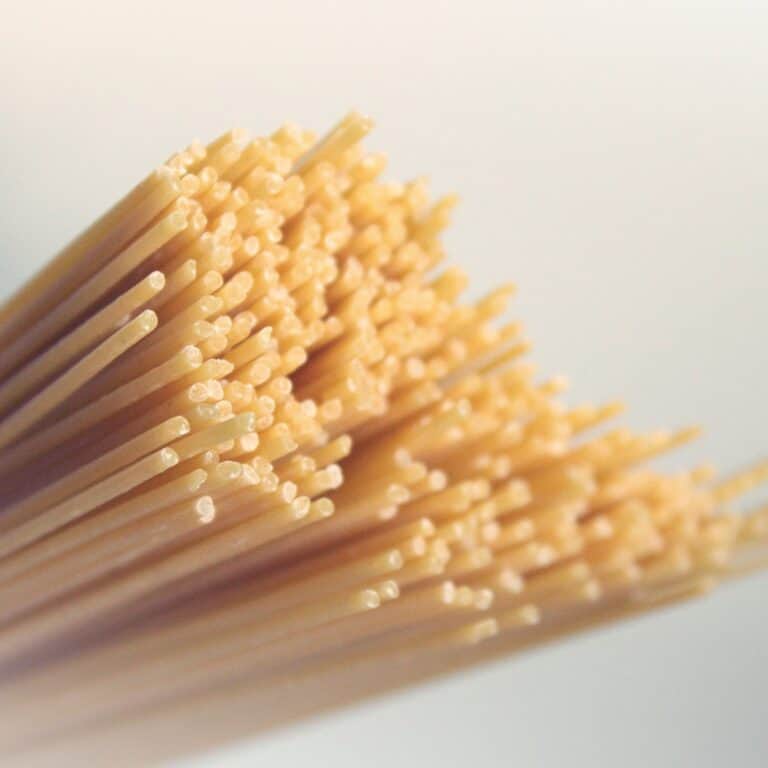Pasta is one of the best prepper foods you can stockpile as it’s easy to prepare, stores well, and is inexpensive. The versatility lies in the number of dishes that can be prepared from it and the calorie-dense nature of the carbohydrates within.

Even without any special storage methods, pasta can hold its own for several months in your pantry. Unfortunately, the packaging it comes in is poor and eventually will let the elements inside.
Storing pasta for the long term is a vital part of the prepping process in that it can potentially preserve your dried pasta for several years. Having a cheap staple on hand when SHTF is priceless, especially if you have several mouths to feed.
How Long Does Dry Pasta Last?
Semolina flour-based pasta will last between 2-3 years unopened without any special storage conditions inside your pantry. If you do end up opening the package then the clock will start ticking for the one-year countdown.
While this isn’t a terrible shelf life, to begin with when you add in elements of light, heat, and moisture you can drastically shorten that life.
If you store your dried pasta correctly then you can extend its edibility by 10+ years over the expiry date. Properly vacuum-sealed pasta with oxygen absorbers inside can keep your dried stock viable for up to 25 years after packaging.
Why Pasta Goes Bad
Unfortunately, as with many things, pasta is susceptible to the common problems that generally face other dried foods. Environmental conditions need to be kept in check since any dried food is sensitive to moisture and will readily absorb both that and scents in the air.
Some of the ways that your pasta can spoil include:
- Mold growth – Primarily caused by wet conditions with no airflow, dark mold can grow and spoil your stored pasta.
- Going rancid – Oils found naturally in the pasta can spoil and produce a rancid taste.
- Insects – While insects generally go towards beans and whole grains, they will eat pasta if it’s around. If you have whole grain pasta then expect them to show up if you’re not diligent in storing it.
- Nutrients and Taste – Stale pasta is caused by oxygen exposure and if you don’t have a sealed bag then it’s only a matter of time before the vitamins within are destroyed. It will still be perfectly edible but will lack the nutritional content that it once had.
Luckily, pasta can hold up to quite a bit of abuse so if you’re diligent about storing it then there is a good chance it won’t go bad on you anytime soon.
Different Kinds of Pasta for Long-Term Storage
There are countless varieties of pasta available and each has its own unique shelf life. For the most part, you’ll have no issues storing your pasta for up to 5 years, with many types going far beyond that.
Dried pasta is the best to preserve for long-term storage. Fresh pasta has too much moisture that severely cuts the shelf life, even with proper storage. Whole wheat and egg pasta are not ideal for long-term storage since they have fats and oils that can spoil and develop nasty rancidity.
Dry Pasta Shelf Life
Check out the chart below for the shelf life of popular styles of pasta. To give you a broad understanding we’ve included the lifespan without proper storage to highlight how much value there is in preserving it.
| Pasta Type | Shelf Life Without Proper Storage | Shelf Life With Proper Storage |
|---|---|---|
| Egg Noodles | 2 Years | 10+ Years |
| Semolina Pasta | 4-5 Years | 15+ Years |
| Vegetable Pasta | 2 Years | 10 Years |
| Gluten-Free Pasta | 2 Years | 5+ Years |
| Whole Grain Pasta | 2 Years | 5+ Years |
Why Should You Store Pasta?
With the availability of dried pasta being so widespread and cheap, beginners may wonder why you would want to store your pasta in anything but the original packaging.
Some folks will argue the usual points which usually sum up to the tune of “having more is better, just in case”. While this is a valid point, there are a few other advantages to think about, as well as some disadvantages to storing pasta.
Advantages
In most cases, preserving the pasta involves either freezing or eliminating any oxygen inside. Creating this kind of inhospitable environment means that insect eggs or existing pests won’t be able to eat away at the food and procreate, ruining all of your food.
Having the extra food around can not just be for emergencies. Inflation-causing price hikes can often make getting certain foods difficult to obtain because they’re so expensive. This buffer in the form of extra pasta in your pantry can help you ride through those short bursts of expense increases.
Disadvantages
Any kind of food preservation is not a cheap endeavor as there are equipment and materials needed for the process. Depending on the amount and how often you do it, if you’re just preserving it to eat within a few months then that makes for an expensive grocery bill.
Storing a large amount of pasta can take up a lot of space, especially if you’re storing it in airtight buckets. Ensure that you have a storage plan for all of your goods or you might run out of space.
How to Store Pasta Long Term
If you’ve ever preserved flour or beans then you have a general idea of what’s needed to store your pasta. Ultimately, you want to eliminate any moisture, air, heat, and light from the environment your pasta is in.
The right room for storing dried pasta will have a temperature between 40 °F (4 °C) and 75 °F (24 °C) with minimum light pollution. Humidity breeds moisture, so try to keep it under 40%. If you can’t control the humidity there are ways to prevent it from getting inside your airtight containers…
Choosing the Right Containers
You have several container options for storing your pasta and it depends on the size of the pasta you’re storing. For example, you would have a taller container for spaghetti than you would for macaroni.
Mylar bags – These are traditionally one of the best options for preserving anything, and as result, mylar bags are a good choice for storing pasta long term
The materials inside can withstand humidity, temperature fluctuations, and light penetration. Store the finished bags in a hard container to keep rodents and other animals out.
Glass jars – A popular airtight container, storing foods in glass jars will keep the elements outside. The downside is that many glass jars are clear which lets a lot of light inside of them.
Vacuum sealing – Portable vacuum sealers are inexpensive for what you get out of them.
The bags are purchased separately and are the major expense for preserving your pasta with this method.
Many Mylar bags have the option to be vacuum sealed, with some even being resealable after. These should also be stored in a hard container so that pests can’t get to them.
Ziploc freezer bags – If you eat your pasta stores relatively quickly then Ziploc bags might be a good alternative for you.
While not airtight, they do prevent moisture from getting into the bag. It does take a while for oxygen to get into the bag but if left for too long your pasta can go rancid or stale.
Every method has its strengths and potential weaknesses but the majority of them will store your food for several years.
Freezing
This is the best way to store your dried pasta, as long as you have power. Subjecting your dried pasta to the deep freeze will kill any pests or insect eggs that might be inside.
This storage method can keep your pasta fresh indefinitely with the only exception being freezer burn if you didn’t get all of the moisture out before storing.
Oxygen Absorbers
These little packets are found in every dehydrated and freeze-dried meal on the market.
It would be advantageous to include these in any of the storage methods mentioned above as they provide that little extra edge when keeping out oxygen.
Oxygen absorbers are made with iron shavings or filings. These absorb oxygen when exposed to any amount of it and they effectively turn into rust.
This oxidative process takes the oxygen from the air and converts it into nitrogen, an inert gas.
Final Thoughts
Storing dried pasta is one of the easiest products to work with. Since it is already dried and devoid of moisture, your job becomes keeping all of the bad stuff away.
Work within your budget to find the most effective solution for your storage needs. A simple mason jar filled with macaroni and some oxygen absorbers will still get you a long shelf life.
Frequently Asked Questions
If you’re looking at storing some noodles that aren’t commonly used then you might find the answer below. These are some of the most common questions people have about the storage life of different noodles.
Oven-ready lasagna noodles can be stored for up to 2 years in their original packaging and 5 years if stored in an airtight container.
This egg-based pasta has a shelf life of two weeks in the original packaging and up to 2 years if frozen. Quality may be affected by long-term storage.
Vegetable pasta has a shelf life of 2 years in the original packaging and 5+ years if stored in mylar bags.

Perrin is an adventure guide and naturalist currently living a nomadic life in the Canadian wilderness. His education and expertise is in wilderness survival and wildlife tracking. He enjoys teaching people about the outdoors and has managed large groups on expeditions.
With several accredited certifications, including being a wilderness first responder and a leave no trace expert, Perrin believes it is important for all of us to reconnect with the natural world.
